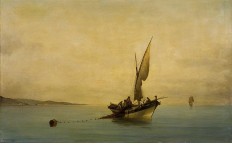TITΛΟΣ ΕΡΓΟΥΜΑΖΕΥΟΝΤΑΣ ΤΑ ΔΙΧΤΥΑ
ΔΙΑΣΤΑΣΕΙΣ ΕΡΓΟΥΎψος : 60
Πλάτος : 95
ΥΛΙΚΟ ΚΑΤΑΣΚΕΥΗΣΕλαιογραφία (Λάδι σε καμβά)
ΥΠΟΓΡΑΦΗ ΚΑΛΛΙΤΕΧΝΗΚάτω Αριστερά
ΧΡΟΝΟΛΟΓΗΣΗ
ΕΛΕΓΧΟΣ ΓΝΗΣΙΟΤΗΤΑΣΔεν έχει ελεγχθεί

Provenance:
Private collection, Athens.
Emotive like pure poetry, Casting the nets is a brilliant evocation of an idyllic and serene Mediterranean seascape, displaying all the hallmarks of Volanakis' finest oils from his Greek period (1884-1907). Particularly remarkable is the sense of open space, a grandiose spread of sea and skyscape animated by subtle but radiant lighting that lends a lyrical resonance to the work. The low horizon that gives full value to the spaciousness of the sky and, in turn, the sky's radiance reflected in the mirror-like surface of calm waters create a unity of effect, capturing the absolute stillness of the hour. According to Professor M. Vlachos, who prepared the monograph on the artist, "Volanakis is always in constant communion with nature, in a composite relationship from which poetry emerges."1 In a similar vein, Professor D. Evangelidis notes: "Often not even a ripple breaks the surface of the sea and only the sails and tall masts chant the harmonies of subdued colours and bring life to his scenes." 2
Highly prized both by the patrons of his day and discerning collectors throughout the 20th century, Volanakis' 'Greek' works combine all three of the artist's favourite themes, namely the sea, the vessel and the sky. Upon his return from Munich, where he studied at the famed Academy of Fine Arts, he took up permanent residency in the seaside town of Piraeus in 1883, and had the opportunity to observe and render the atmospheric changes, the delicate nuances of the seascape and the soft gradations of light and shade with greater accuracy, capturing the warmth and poetry of his homeland.
A serenely luminous painting of technical virtuosity and delicacy of touch, Casting the nets showcases the quintessential vocabulary of Volanakis' art: sensitive lighting and colour, feathered brushwork, harmony of proportion and superb compositional structure. The sidelong depiction of the fishing boat creates a powerful diagonal that intersects with the equally strong diagonal defined by the floating net corks, drawing the eye to the human activity inside the boat and the wonderful reflections that flicker on the still waters, while the tall sail establishes a powerful vertical set against the long horizon. This fine interplay of structural lines is further animated by the curvilinear form of the typical Greek caique, which generates a circular movement that directs the eye from the floating buoy to the vessel, to the distant shore and back to the foreground. As in many of his most characteristic works, Volanakis selected the subject of the fishing boat to exploit its romantic elements rather than to portray toil and struggle. "His love for and familiarity with small vessels produced works of pure lyricism." 3
Indeed, a strong romantic feeling permeates the entire composition. The unity of effect, the sense of peace and the poetry of the scene become means of expressing the artist's view of the transience of life. "Volanakis' romantic soul seeks inner peace in the beauty of a dreamworld full of light and colour, where reverie is a kind of prayer. He is simply interested in a vertical and a horizontal to create a metaphysical stillness. That's why he prefers calm seas and spring or summer skies. Rarely do his clouds warn of a coming storm." 4
1. M. Vlachos, The Painter Constantinos Volanakis (doctorate thesis) [in Greek], Athens 1974, p. 105.
2. D. Evangelidis, Greek Art [in Greek], Athens 1969, p. 128.
3. Vlachos, 'Constantinos Volanakis' in Greek Painters [in Greek], vol.1, Melissa, Athens 1974, p. 202. See also Vlachos, The Painter Constantinos Volanakis, p. 117.
4. S. Lydakis, 'Volanakis, a Pioneer' [in Greek], Epta Imeres (Kathimerini), 22.02.1998, p. 14.